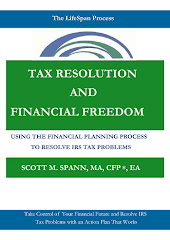
It is no surprise that most Americans dread April 15th when the deadline looms for filling out federal and state income tax returns. On the surface, learning the tax code can appear more complicated than learning a new language. In fact, sometimes I read the tax code and wonder if the IRS is speaking English.
Have you ever vowed to yourself at tax time that you will be better prepared "next year" only to experience the exact same frustration when next year arrives? It is becoming a popular New Year's resolution for people to promise themselves that they will do a better job at maintaining accurate records and getting organized, or that they will pay closer attention to possible tax-saving measures. Unfortunately, many people simply do not follow through with that commitment.
Engagement in the tax and financial planning process provides taxpayers with an opportunity to take control of their income tax concerns. Instead of being a typical taxpayer and waiting for the deadline to arrive, you should plan ahead and file your tax returns prior to the April 15th deadline. Most importantly, you should file those tax returns with confidence that you are in control of your financial destiny. You may even decide to go ahead and schedule your own deadline of March 15th or April 1st and hold yourself accountable to a self-imposed deadline to defeat the temptations of procrastination. If everything goes smoothly you should celebrate your step toward total tax and financial freedom.
Disclaimer: Please note that the term "tax freedom" does not mean you will likely ever be completely free from paying taxes in this country. However, tax freedom can be achieved by taking control of your tax situation and minimizing the impact of current and future taxes with a plan that works.
Whether or not you choose to use the services of a tax professional is a personal decision and depends on your individual level of confidence with tax and other financial matters. For most taxpayers with a history of recent tax and financial problems I suggest the use of professional tax preparation services for at least a couple of years. At a minimum you should at least use some type of tax preparation software to assist with the process. Turbo Tax, Tax Wise, and Tax Cut are some of the most popular software programs that my clients have used successfully to help prepare tax returns.
Tax planning is more than just trying to reduce your overall taxes. Income tax planning decisions should always be part of your overall financial life plan. Always coordinate tax planning with your comprehensive financial planning goals and objectives. If you are working with a CPA, EA, or other tax professional be sure that they are communicating with your financial planner or other financial advisory team members.
Holistic tax planning requires a deeper focus than just trying to lower taxes. Tax reduction is great. However, it is more meaningful when used in conjunction with bigger picture planning. If you have not done so already this year, take a few moments to review your income tax plan. Don't have a formal tax plan in place? It is not too late to start. Next tax season is not too far away and will be a lot more enjoyable for the taxpayers that take the time to prepare for April 15th throughout the course of the year.






